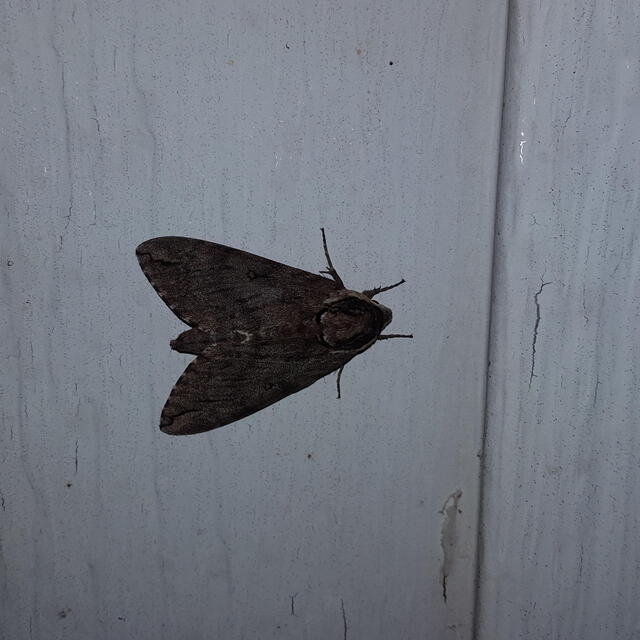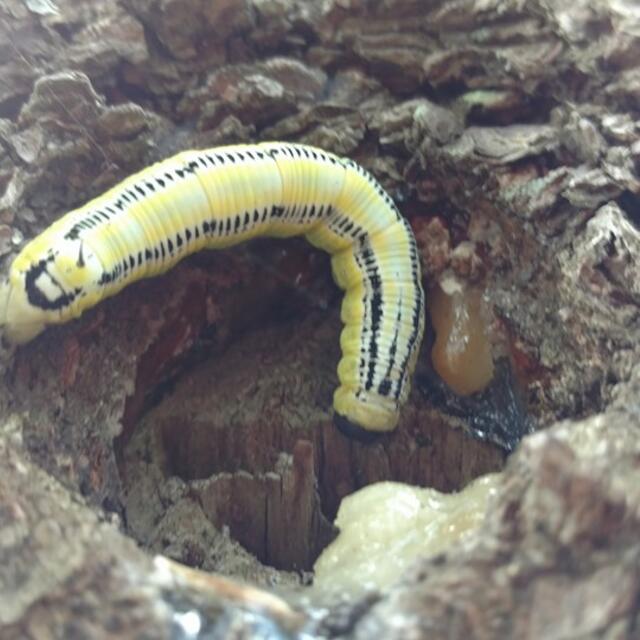Catalpa sphinx
Ceratomia catalpae (Boisduval, 1875)
Family: Sphingidae
Subfamily: Sphinginae
Identification: Forewing is yellowish brown with no white markings and indistinct black lines and dashes. Cell spot is gray with a black outline. Hindwing is yellowish brown with obscure lines.
Wing Span: 2 9/16 - 3 3/4 inches (6.5 - 9.5 cm).
Life History: Adult moths fly at night. Females lay large clusters of eggs on the underside of host leaves or smaller clusters on twigs and branches. Young caterpillars feed together in groups; older ones feed singly. Fully-grown caterpillars crawl down the tree trunk to pupate and overwinter in chambers dug 2-3 inches into the soil. Caterpillars are often parasitized by a wasp, Apanteles congregatus, which lays its eggs inside the caterpillar. The caterpillar eventually dies as the wasp larvae feed inside it.
Flight: . Two flights from May-September.
Caterpillar Hosts: Catalpa species in the Bignoniaceae family.
Adult Food: Adults probably do not feed.
Habitat: Deciduous woodlands and suburban plantings.
Range: Eastern states from Maine west to Iowa; south to Florida, the Gulf States, and Texas. Also Colorado and Nebraska. Comment: Caterpillars are used as fish bait in the Southeast.
Conservation: Not usually required.
NCGR: G5 - Demonstrably secure globally, though it may be quite rare in parts of its range, especially at the periphery.
Management Needs: During outbreaks, caterpillars can defoliate catalpa trees.
Comments: NULL
Please donate!
We depend on donations to keep Butterflies and Moths of North America freely available. We want to express our gratitude to all who showed their support by making a contribution this year. You can donate to support this project at any time.
Advertise with us!
Do you have a product or service that you think would interest BAMONA users? If you would like to advertise on this website, contact us by email, or use the contact form and select the "Advertising" category.
Verified Sightings
Displaying 1 - 24 of 518 verified sightings

Observation date: Aug 22, 2025
Submitted by: Eddie Wyatt
Region: York County, Pennsylvania, United States
Verified by: curtis.lehman
Verified date: Aug 25, 2025

Observation date: Aug 24, 2025
Submitted by: jrtindall
Region: Mercer County, New Jersey, United States
Verified by: curtis.lehman
Verified date: Aug 24, 2025

Observation date: Aug 13, 2025
Submitted by: eattaway92
Region: Will County, Illinois, United States
Verified by: rogerdowner
Verified date: Aug 24, 2025

Observation date: Aug 24, 2025
Submitted by: tlhallam81
Region: Madison County, Indiana, United States
Verified by: rogerdowner
Verified date: Aug 24, 2025

Observation date: Jul 08, 2022
Submitted by: c4c
Region: Botetourt County, Virginia, United States
Verified by: jmgesell
Verified date: Jul 27, 2025

Observation date: Jul 21, 2025
Submitted by: Ralphielionel
Region: Pottawattamie County, Iowa, United States
Verified by: jmgesell
Verified date: Jul 23, 2025

Observation date: Jul 15, 2023
Submitted by: gjkoppel
Region: Highland County, Ohio, United States
Verified by: rogerdowner
Verified date: Oct 05, 2024

Observation date: Aug 17, 2024
Submitted by: Ozark_Bill
Region: Washington County, Missouri, United States
Verified by: Ozark_Bill
Verified date: Sep 17, 2024

Observation date: Sep 12, 2024
Submitted by: KABerry
Region: Butler County, Pennsylvania, United States
Verified by: curtis.lehman
Verified date: Sep 14, 2024

Observation date: Aug 30, 2024
Submitted by: NNing
Region: Geauga County, Ohio, United States
Verified by: rogerdowner
Verified date: Aug 31, 2024

Observation date: Jul 03, 2024
Submitted by: DanyelleKate
Region: Staunton, Virginia, United States
Verified by: rogerdowner
Verified date: Jul 04, 2024

Observation date: Jun 05, 2024
Submitted by: longstrangetrip
Region: Dorchester County, Maryland, United States
Verified by: rogerdowner
Verified date: Jun 13, 2024

Observation date: May 09, 2024
Submitted by: Mark Vass
Region: Washington County, Pennsylvania, United States
Verified by: curtis.lehman
Verified date: May 10, 2024

Observation date: Aug 22, 2019
Submitted by: Sharonf1997
Region: Fleming County, Kentucky, United States
Verified by: CA Ivy
Verified date: Aug 27, 2023

Observation date: Aug 26, 2023
Submitted by: Steven Wilson
Region: Fayette County, West Virginia, United States
Verified by: curtis.lehman
Verified date: Aug 26, 2023

Observation date: Jul 29, 2023
Submitted by: Shane Miller
Region: Beaver County, Pennsylvania, United States
Verified by: curtis.lehman
Verified date: Aug 01, 2023

Observation date: Sep 19, 2021
Submitted by: Susan McSwain
Region: Nelson County, Virginia, United States
Verified by: rogerdowner
Verified date: Jul 15, 2023

Observation date: Jun 10, 2023
Submitted by: JamieLynn
Region: Aiken County, South Carolina, United States
Verified by: Dennis Forsythe
Verified date: Jun 11, 2023

Observation date: Nov 03, 2015
Submitted by: Bogfinder
Region: Beaver County, Pennsylvania, United States
Verified by: curtis.lehman
Verified date: Mar 30, 2023

Observation date: Sep 28, 2014
Submitted by: jnchandler
Region: Maryland, United States
Verified by: rogerdowner
Verified date: Mar 18, 2023

Observation date: Jul 23, 2016
Submitted by: thanos15084
Region: United States
Verified by: curtis.lehman
Verified date: Feb 04, 2023

Observation date: Jul 21, 2016
Submitted by: Beccaplatt
Region: United States
Verified by: curtis.lehman
Verified date: Feb 04, 2023

Observation date: Jul 19, 2016
Submitted by: akoparrell
Region: United States
Verified by: curtis.lehman
Verified date: Feb 04, 2023

Observation date: Jul 15, 2016
Submitted by: pcard74
Region: United States
Verified by: curtis.lehman
Verified date: Feb 04, 2023
- 1 of 22
- next ›






